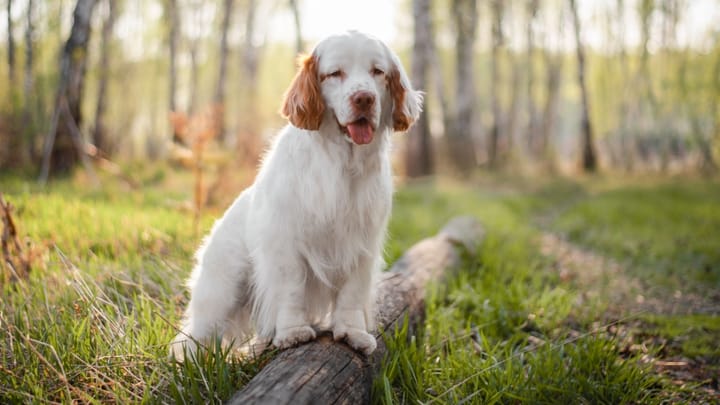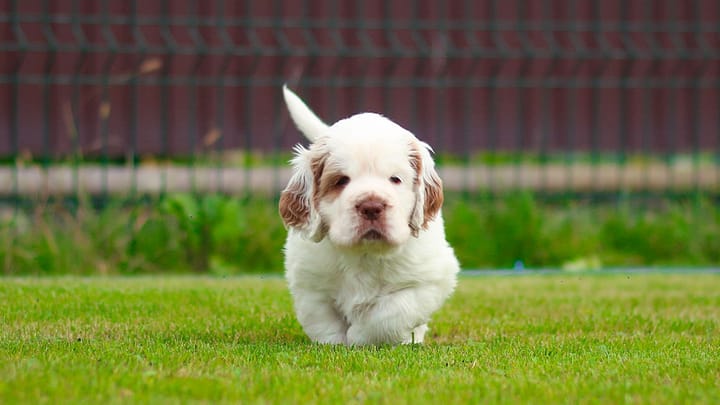Clumber Spaniel


The largest of the spaniel breeds, the Clumber Spaniel is a large, heavy-bodied dog. His name is taken from Clumber Park in Nottinghamshire, where this breed was first developed. The Clumber Spaniel was first used as a gun dog and specialised in tracking prey through dense countryside. This is a gentle and loyal breed, which can be a little aloof around strangers.
|
Life expectancy |
The Clumber Spaniel has a life expectancy of between 10 and 12 years |
|
Temperament |
|
|
Size |
Medium
|
|
Adult size |
Female
Between 17 and 18 in
Male
Between 18 and 19 in
|
|
Adult weight |
Female
Between 55 and 64 lb
Male
Between 64 and 75 lb
|
|
Coat colour
White, white and orange. |
White |
|
Type of coat
Abundant, tight, silky and straight. Medium-length. |
Long |
|
Eye colour
Brown, orange. |
Brown
|
|
Purchase price |
The Clumber Spaniel costs between £600 and £900 |
Clumbers have a tendency to drool a lot. They’re also big snorers.
Clumbers often have difficulties giving birth. Many require C-sections.
More details about the Clumber Spaniel
Clumber Spaniel: Origins and history
Not much is known about these dogs before the mid 19th century.
Some reports claim that they originated in France when the little-known Spaniel of the Alps crossed with the French Bassets. At the end of the 18th century, when the French Revolution broke out, the Duke of Noailles sent his dogs to England to save them. The friend who received these dogs was the second Duke of Newcastle at Clumber Park, hence the name of the breed.
However, some authors maintain that this is only a legend and that this dog is instead of English origin. The Duke of Newcastle is indeed already represented on a painting from 1788 with three dogs that look like Clumber Spaniels and who could very well be the ancestors of this dog. They were a popular choice for members of the British Royal Family. Illustrious owners include Prince Albert, Edward VII, and George V.
They were introduced into Canada and the USA in 1844 and were one of the first ten breeds to be recognised by the American Kennel Club.
Physical characteristics of the Clumber Spaniel
The Clumber is a very special spaniel, and different from his cousins. A large, heavy-set dog with a long, dense coat, and a low tail, he has a big, square head, flat ears that hang forward, and a soft and thoughtful expression. His body is chunky and barrel shaped, with short, stubby legs.
FCI classification of the Clumber Spaniel
-
Group 8 - Retrievers - Flushing Dogs - Water Dogs
-
Section 2 : Flushing Dogs
Clumber Spaniel: Characteristics
Clumber Spaniel: Behaviour
Training a Clumber Spaniel
This dog is fairly easy to train. He should be educated from an early age, with firmness and gentleness, consistency and respect. This is a dog who quickly understands what is expected of him.
Clumber Spaniel: Lifestyle
Breed compatibility Clumber Spaniel
Clumber Spaniel: Purchase price
Between £600 for Non KC Registered dogs, and £900 for KC Registered dogs. Looking after a dog of this size typically costs between £90 to £140 a month, including food, medical/insurance, and incidental expenses.
Clumber Spaniel: Grooming
His coat requires lots of grooming. He needs to be brushed every few days to avoid knots, and trimmed once every few weeks.
Clumber Spaniel: Health
This is a generally healthy breed, with an average life expectancy of 11 years.
The Clumber Spaniel is a big, strong, and sturdy animal, who can nevertheless have various health issues.
Because of his thick coat, the Clumber can suffer from heat sensitivity. Keep him in the cool during the hottest parts of the day.
He has a thick dense coat that keeps him warm and dry through the winter, but he must have a shelter if he lives in the garden.
Older Clumbers tend to pile on a few extra pounds. As they age, they become less active. Reduce food intake accordingly.
- Hip Dysplasia
- Spinal disc herniation
- Entropion
- IOCH (incomplete ossification of the humeral condyle)
- Uterine inertia
- Ear infections
- Obesity
- Difficult farrowing






